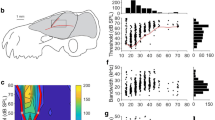Summary
Electrophysiological recordings were made from 130 single neurons of the superior colliculus (SC) of big brown bats,Eptesicus fuscus, in order to test their general as well as directional auditory response properties. Bursts of constant frequency and frequency modulated signals were broadcasted through a condenser loudspeaker, which could be placed at any azimuth and elevation on a hemisphere in front of the bat's head. The SC units responded equally well to both types of signals. The best frequencies of SC neurons ranged from 25 up to 82 kHz, and their tuning curves appeared to be broad (compared to those of the main auditory nuclei of the same and other bats) with Q10dB values of 1.8–17.5. All units encountered revealed directional sensitivity and were classified in two groups: the majority of them had a constant best angle of response (BA) whatever the sound intensity was (unidirectional type); the others showed a shift in their BA towards the center of the stimulating hemisphere as the intensity decreased (pluridirectional type). In both response types, the BA results are corroborated by the properties of the receptive fields. The presence of an auditory ‘space map’ in the horizontal plane is not obvious for the superior colliculus of this bat.
Similar content being viewed by others
Abbreviations
- BA :
-
best angle
- BF :
-
best frequency
- CF :
-
constant frequency
- FM :
-
frequency modulated
- FTC :
-
frequency threshold curve
- IC :
-
inferior colliculus
- MLD :
-
nucleus mesencephalicus dorsalis
- MT :
-
minimum threshold
- RF :
-
receptive field
- RP :
-
reference point
- SC :
-
superior colliculus
- SPL :
-
sound pressure level re. 20 μPa·cm−2
References
Buchler ER, Childs SB (1981) Orientation to distant sounds by foraging big brown bats (Eptesicus fuscus). Anim Behav 29:428–432
Dräger UC, Hubel DH (1975) Responses to visual stimulation and relationship between visual, auditory and somatosensory inputs in the mouse superior colliculus. J Neurophysiol 38:90–713
Gordon B (1973) Receptive fields in deep layers of the cat's superior colliculus. J Neurophysiol 36:157–178
Griffin DR (1958) Listening in the dark. Yale University Press, New Haven, Connecticut
Grinnell AD (1963) The neurophysiology of audition in bats: Directional localization and binaural interaction. J Physiol (Lond) 167:97–113
Horn G, Hill RM (1966) Responsiveness to sensory stimulation of units in the superior colliculus and subjacent tectotegmental regions of the rabbit. Exp Neurol 196:502–507
Jen PH-S (1974) Coding of directional information by single neurons in the superior olivary complex of echolocating bats. PhD thesis, Washington University, St Louis
Jen PH-S (1980) Coding of directional information by single neurons of the S-segment of the FM bat,Myotis lucifugus. J Exp Biol 87:203–216
Jen PH-S, Schlegel PA (1980) Neurons in the cerebellum of echolocating bats respond to acoustic signals. Brain Res 196:502–507
Jen PH-S, Schlegel PA (1982) Auditory physiological properties of neurons in the inferior colliculus of the big brown bat,Eptesicus fuscus. J Comp Physiol 147:351–363
Kellog WN (1962) Sonar system of the blind. Science 137:399–404
King AJ, Palmer AR (1983) Cells responsive to free-field auditory stimuli in guinea-pig superior colliculus: distribution and response properties. J Physiol (Lond) 342:361–381
Knudsen El (1982) Auditory and visual maps of space in the optic tectum of the owl. J Neurosci 2:1177–1194
Knudsen EI, Konishi M (1978) Space and frequency are represented separately in auditory midbrain of the owl. J Neurophysiol 41:870–883
Neuweiler G (1970) Neurophysiologische Untersuchungen zum Echoortungsystem der Großen Hufeisennase,Rhinolophus ferrumequinum Schreber, 1774. Z Vergl Physiol 67:273–306
Palmer AR, King AJ (1982) The representation of auditory space in the mammalian superior colliculus. Nature 299:248–249
Poussin C, Simmons JA (1982) Low frequency hearing in the echolocating bat,Eptesicus fuscus. J Acoust Soc Am 72:340–342
Pye JD, Roberts LH (1970) Ear movements in a hipposiderid bat. Nature 225:285–286
Pye JD, Flinn M, Pye A (1962) Correlated orientation sounds and ear movements of horseshoe bats. Nature 196:1185–1188
Rauschecker JP, Harris LR (1983) Auditory compensation of the effects of visual deprivation in the cat's superior colliculus. Exp Brain Res 50:69–83
Ryan MJ, Tuttle MD, Barclay MR (1983) Behavioral responses of the frog-eating bat,Trachops cirrhosus, to sonic frequencies. J Comp Physiol 150:413–418
Schlegel PA (1977) Directional coding by binaural brainstem units of the CF-FM batRhinolophus ferrumequinum. J Comp Physiol 118:327–352
Suga N, Schlegel P (1972) Neural attenuation of responses to emitted sound in echolocating bats. Science 177:82–84
Tuttle MD, Ryan MJ (1981) Bat predation and evolution of frog vocalizations in the neotropics. Science 214:677–678
Vater M, Schlegel P (1979) Comparative auditory neurophysiology of the inferior colliculus of two molossid bats,Molossus molossus andMolossus ater. II. Single unit responses to frequency modulated signals and signal noise combination. J Comp Physiol 131:147–160
Author information
Authors and Affiliations
Rights and permissions
About this article
Cite this article
Poussin, C., Schlegel, P. Directional sensitivity of auditory neurons in the superior colliculus of the bat,Eptesicus fuscus, using free field sound stimulation. J. Comp. Physiol. 154, 253–261 (1984). https://doi.org/10.1007/BF00604991
Accepted:
Issue Date:
DOI: https://doi.org/10.1007/BF00604991




